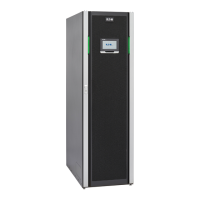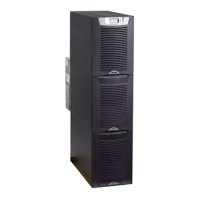33 Eaton® 9390 (100–160 kVA) UPS Installation and Operation Manual 164201604—Rev F
66..44 IInnssttaalllliinngg aa RReemmoottee IInntteerrffaaccee MMoodduullee ((RRIIMM))
To install RIM wiring:
1. Verify the UPS system is turned off and all power sources are removed. See
Chapter 9 UPS Operating Instructions for shutdown instructions.
2. Perform the procedure listed in 6.1 Installing an Eaton Hot Sync CAN Bridge Card.
NNOOTTEE If mounting to a hollow wall, secure the enclosure to a wood or metal stud within the
wall. DO NOT use hollow wall anchors.
3. Securely mount the RIM at the desired location. See Figure 90 for mounting hole locations.
NNOOTTEE 11 When installing signal wiring for CAN Bridge Card card J3 terminals, conduit must be
installed between the device and the UPS cabinet.
NNOOTTEE 22 Remove the UPS cabinet top or bottom conduit landing plate to drill or punch conduit
holes (see Figure 84).
4. Remove the X-Slot conduit landing plate from the UPS cabinet to drill or punch conduit holes (see
Figure 84).
5. Reinstall the conduit landing plate.
6. Install conduit between the UPS and RIM. See Chapter 15 Installation Information for UPS cabinet and
RIM wiring access information.
7. Install wiring between the UPS and RIM. See Figure 86 for Eaton Hot Sync CAN Bridge Card and RIM
location, terminal location, and wiring information.
NNOOTTEE The 120 Vac for the RIM should be supplied from the critical bus by facility planners or
the customer.
8. Install 120 Vac power wiring from the critical bus to the RIM. See Figure 86 for terminal location and wiring
information.
NNOOTTEE Setup of the Eaton Hot Sync CAN Bridge Card must be performed by an authorized
Eaton Customer Service Engineer. Contact service to schedule a date.
9. Contact your Eaton service representative for verification and testing of the RIM and its connections prior
to making connections with J1 through J4 (see Table 2 and Figure 90).
You can order interface cables separately for connecting to the 15-pin D-sub Connectors.
Installing Optional Accessories

